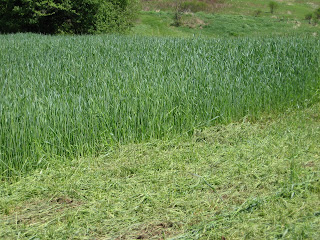Today is the last scheduled work day for our season until early Spring. This is the part of gardening that many forget to do. I didn't use cover crops or even mulch for years. There are some great posts on this blog from our darling Amy about the benefits of mulching and cover crops share many of the same. It is a great way to enrich the soil, leaving it ripe and ready when you need it in the Spring.
Last year we planted all garlic. That was a great crop since we could easily use it and also sold much of it at our Urban Farmers Market. This year we're also using Rye. Eric from Shepards Corner sold a large bag to us for $20 and it will be enough seed for several gardens throughout the University Area. Rye is great for Ohio, as it is tolerent of our cold winters...though as the weather has been going the past few years, who knows!? If you are an industrious person, you could also use it to make Rye bread.
If you read this post and want to stop by and get a bag of free seed, stop on by at The Weinland Park Community Garden, behind 303 E.6th St., Godman Guild, Cols, 43201---bring your own bag (BYOB...tee, hee) and it's first come, first serve. You could also meet some great people, share some gardening tips and have some fun. Below is a great article from Organic Gardening reviewing many cover crop choices:
By Erika Jensen
In This Article
Rodale's All-New Encyclopedia of Organic Gardening
The Easiest Cover Crops
Which cover crop is right for you? "You have to keep in mind the time of year and the species you are growing," says Diver. Some, such as cereal rye, are very cold-tolerant and work well for late-season plantings. Others, such as buckwheat, are very frost-tender. The cover crops listed here are widely adapted and can be grown in most areas of the United States, either as a summer or winter cover crop, depending on where you live.
Rye. This crop comes in two different types: annual rye and cereal rye. Both have their advantages. Sow cereal rye during the late summer or early fall, and it will grow until late in fall and resume growing in spring. With annual rye, which winter kills in USDA Plant Hardiness Zones 5 and colder, you'll be able to plant your garden earlier, since you won't have to turn the cover crop into the soil and then wait three weeks as you would with a perennial cover crop.
Field peas/oats. This dynamic duo combines the benefits of a legume (peas) that fixes nitrogen and a grain (oats) that contributes plenty of organic matter. And the plants have complementary growth habit—the peas climb right up the oats. Both crops are cold-tolerant, which makes this a good mixture to plant in late summer or early fall. In colder climates, they will also winter kill, allowing an early spring start.
Sorghum-sudangrass. As its name suggests, this grass is a cross between sorghum and sudangrass. This hybrid generates large amounts of organic matter and needs little encouragement to grow 5 to 12 feet tall. You can keep this frost-tender plant in check by mowing it down to 6 inches when it reaches a height of 3 feet or by planting it just seven weeks before frost.
Buckwheat. It's not wheat, and it's not a Little Rascals character! Buckwheat is a broadleaf plant and an excellent smother crop—it's effective even against weeds like quackgrass. "Buckwheat is very fast-growing and can provide a quick canopy to shade weeds. Just be careful to not let it go to seed, or you'll have buckwheat in your next crop," says Dr. Creamer. It matures in just six to eight weeks and can be squeezed in between spring and fall vegetable plantings. Buckwheat's white flowers serve two purposes—they work well as a filler for flower arrangements, and they attract beneficial insects.
Clover. Clover comes in a plethora of different shapes and sizes. White Dutch clover works well as a living mulch, since it tolerates both shade and traffic. Yellow blossom sweet clover is an excellent nutrient scavenger and helps build good soil structure. Crimson clover attracts beneficials and looks great, too. Whatever the color, clover fixes nitrogen and helps to build rich soils. For best results, make sure you inoculate your clover seed with Rhizobium bacteria (available from Peaceful Valley Farm Supply, 888-784-1722, http://www.groworganic.com/).
SOURCES The one drawback of cover-cropping for gardeners is that you may pay premiums for seed in small packages rather than a farmer's bulk seed prices. Check with your local farm supply store for seed- they may be willing to order varieties they don't normally carry. The following are mail order sources for untreated and certified organic cover crop seed:


No comments:
Post a Comment